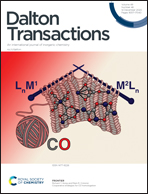Enhanced E/Z-photoisomerization and luminescence of stilbene derivative co-coordinated in di-β-diketonate lanthanide complexes†
Abstract
A new tetradentate chelating ligand appending a stilbene derivative, E-N′,N′-bis(pyridin-2-ylmethyl)-4-styrylbenzohydrazide (HL) was synthesized, together with two β-diketonates (4,4,4-trifluoro-1-phenylbutane-1,3-dionate, tfd), with or without the trifluoroacetate anion present as a ligand for coordination with lanthanide(III) ions to form [Ln(tfd)2(HL)(CF3CO2)] (LnC49H36F9N4O7, Ln = La (1), Nd (2), Eu (3), Gd (4)) and [Yb(tfd)2(L)] (YbC47H35F6N4O5 (5), L = deprotonated HL). All five complexes were structurally characterized, and five crystals were obtained and analyzed by single-crystal X-ray diffraction. The quantum yield of trans-to-cis photoisomerization of the stilbene group in gadolinium complex 4 was enhanced about five-fold compared with that of HL itself. Other complexes showed slightly enhanced or depressed photoisomerization. The total luminescence quantum yield/sensitization efficiency of europium complex 3 in the solid state and acetonitrile solution were 22.1%/96.7% and 19.3%/97.9%, respectively. The transfer of ligand energy to the Eu3+ ion was highly efficient. This enhanced photoisomerization and luminescence of the stilbene group within complexes was found to be related to the energy level of lanthanide ions and whether a ligand-to-metal center or ligand-to-ligand charge transfer process was present. The interpretation of experimental results is rationally supported by time-dependent density-functional theory calculations. In complex 4, except for the intramolecular absorption transition of HL ligand itself (IL, πHL–π*HL), the presence of the ligand-to-ligand charge transfer transition from tfd to HL (LLCT, πtfd–π*HL) and the triplet state energy of HL being unable to transfer to the higher 6P7/2 excited energy level of the Gd3+ ion would facilitate HL photoisomerization. For complex 3, this was due to reversed ligand-to-ligand charge transfer transition from HL to tfd (LLCT, πHL–π*tfd) and its energy transfer to the metal center. Although the observed radiative lifetimes of NIR luminescent complexes 2 and 5 were around 10 μs, these systems contained only two diketone ligands, indicating that HL still had a certain promoting effect compared with tris(diketonate) lanthanide complexes. These results offer an important route for the design of new lanthanide-based molecular switching materials.



 Please wait while we load your content...
Please wait while we load your content...